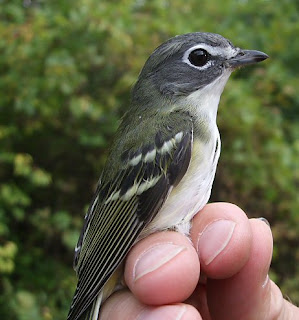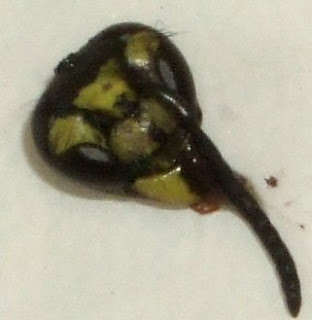
My husband Darrin and I have just returned from a trip to the western state of Jalisco, Mexico (highlighted above). You might recall that last year
we went to Nicaragua where we conducted bird and insect surveys and did some
bird banding on a shade coffee farm. This Mexican trip was sponsored by
Rocky Mountain Bird Observatory in Colorado, which has done a
great deal of work in this area. Our trip supported conservation work in Jalisco, an area where there are many endemic bird species found nowhere else in the world.
While our itinerary took us to several locations, I'll focus here on a visit to the Las Joyas research station in the
Sierra de Manantlán Biosphere Reserve, where we, too briefly, learned about and lent a hand in one of the longest-running and most intensive bird banding projects in Mexico.
The
Sierra de Manantlán Biosphere Reserve covers 1400 km² (roughly 350,000 acres). It was established in 1987, after being acquired by the government to preserve a large population of a rare species of wild maize,
Zea diploperennis. The 345 km² of tropical dry forest in the reserve is the largest of its type protected in Mexico, and the 50 km² of cloud forest portion is the largest protected on Mexico's Pacific slope. Much of the land in Mexico is owned communally under the
ejido system. Because there are so many landowners, biospheres in the country are structured so that there is a core area in which little or no human impact is allowed, and a buffer zone where managed activities such as sustainable agriculture can take place. A
general map of the area is here.
The Las Joyas field station is operated by the University of Guadalajara in the core zone, and is not open to the public. If you put these coordinates <19.586010,-104.274028> into Google Maps or Earth and zoom in on the marker, you can see the buildings as well as the remoteness. The station is quite rustic, with solar power and outhouses with composting toilets. We slept in a dorm, 4 beds to a room, with thin walls that did not keep out the night-time chill at nearly 2000 meters! We were also warned to use a flashlight and beware of mountain lions and jaguars if we went to the outhouses at night. Four other wild cats are also common there: bobcats, ocelots, margays, and jaguarundis. Alas, we did not see any of them.
In the center is the dorm at Las Joyas; outhouses at left and kitchen at right.
The area around the dorms was full of bird life. The most common species were many usually-hard-to-see
Crested Guans (
Penelope purpurascens), roosting in the trees and flying back and forth; multiple sallying
Tufted Flycatchers (
Mitrephanes phaeocercus); several male
Brown-backed Solitaires (
Myadestes occidentalis) in constant song; and a pair of uncharacteristicly cooperative
Blue Mockingbirds (
Melanotis caerulescens).
Singing Quail (
Dactylortyx thoracicus) and
Long-tailed Wood-Partridge (
Dendrortyx macroura, a Mexican endemic) also lent their voices to the morning chorus; we got great looks at the wood-partridges at the compost pile.
The banding "station" is a table set up along a trail. Ten nets are run two days a week all year long, manned by station regulars and students working on various projects. I was very impressed by the speed and skill of the student banders, as well as the many scientific publications which have resulted from work here.

At left, University of Guadalajara's Sarahy Contreras explains some background of the banding project at Las Joyas, in which she has been involved for many years.
We just didn't take enough pictures. The pace of bird captures was steady in the morning. The students or Darrin and I were nearly always off checking nets, extracting birds, and bringing them back to the banding table. We were happy to help out even as most of our group went off for a walk.
The most common North American migratory species were Wilson's Warbler and Nashville Warbler. Most of the birds were residents, though, and a lot of them were hummingbirds.

They had a whole range of tiny hummingbird bands arranged in mint tins, and an array of special banding pliers to put the bands on. Some species we had that day were White-eared, Magnificent, Rufous, and Berylline Hummingbirds, and Green Violetear.
Here are a few of the highlights for me:

Cinnamon-bellied Flowerpiercers (
Diglossa baritula) feed on nectar. The long hook at the tip of the bill is used to hold flowers firmly, while they stab the base of the flower corolla with their pointy lower bill and extract nectar by inserting their tongues through the slit. This is done incredibly fast! This is a small bird, perhaps the size of a Magnolia Warbler.

Golden-browed Warbler (
Basileuterus belli).

Dwarf Vireo (
Vireo nelsoni). I think this was the only bird we heard in the field but only saw in the hand. It is a very poorly known species endemic to Mexico. It's nearest relative is the endangered Texas-breeding
Black-capped Vireo (
Vireo atricapillus) -- one of which we also saw at a lower elevation! Black-caps have a very restricted wintering range in western Mexico, and the bird we saw was banded, most likely at the same wintering site by Sarahy two years before.
We had 8 species of vireo on the trip, including
Golden Vireo (
Vireo hypochryseus) and
Chestnut-sided Shrike-Vireo (
Vireolanius melitophrys).
Of course, as in Nicaragua, I was happy to get an opportunity to handle a couple of south-of-the-border
Catharus thrushes, related to the birds
I study here at RRBO.

Here is an Orange-billed Nightingale-thrush (
Catharus aurantiirostris). They are smaller than a Hermit Thrush, generally the smallest
Catharus thrush we get here in Michigan.

And here I am with a Russet Nightingale-thrush (
Catharus occidentalis).
On the trip, we saw many other spectacular species. Among my favorites were:
Citreoline Trogon (
Trogon citreolus) -- endemic to Mexico.
Pale-billed Woodpecker (
Campephilus guatemalensis) -- a relative of the extinct Imperial and Ivory-billed Woodpeckers.
San Blas Jay (
Cyanocorax sanblasianus) -- endemic to Mexico.
Red-breasted Chat (
Granatellus venustus) -- endemic to the Pacific slope of Mexico.
Red-headed Tanager (
Piranga erythrocephala) -- endemic to Mexico.
Rufous-capped and
Green-striped Brush-Finches (
Atlapetes pileatus and
Arremon virenticeps) -- both endemic to Mexico.
Rusty-crowned Ground-sparrow (
Melozone kieneri) -- endemic to west Mexico.
Orange-breasted Bunting (
Passerina leclancherii) --
eye-popping Mexican endemic.
Our small group tallied around 250 species. Many thanks to Arvind Panjabi, Sarahy Contreras, Eduardo Santana, and Siux Diaz for hosting this great trip.
 We banded two other unusual birds this week. The first was this dark, heavily marked form of the Veery, matching descriptions of the Newfoundland race.
We banded two other unusual birds this week. The first was this dark, heavily marked form of the Veery, matching descriptions of the Newfoundland race.  The other surprise was this European Goldfinch. RRBO has done a lot of research on this species. While not a first for Dearborn, it was interesting nonetheless. This individual was not a wild vagrant from Europe, but an escaped or released cage bird.
The other surprise was this European Goldfinch. RRBO has done a lot of research on this species. While not a first for Dearborn, it was interesting nonetheless. This individual was not a wild vagrant from Europe, but an escaped or released cage bird. We banded four species of vireos this week: Warbling, Red-eyed (we're already at our fall average), Philadelphia, and Blue-headed. I think Warbling Vireos look angry, while Philadelphia Vireos, like the one below, look "cute."
We banded four species of vireos this week: Warbling, Red-eyed (we're already at our fall average), Philadelphia, and Blue-headed. I think Warbling Vireos look angry, while Philadelphia Vireos, like the one below, look "cute." Blue-headed Vireos are one of my favorite species. We don't catch a lot of them, and they are just so handsome.
Blue-headed Vireos are one of my favorite species. We don't catch a lot of them, and they are just so handsome.

 We've been getting a lot of great samples for our study of what fruits birds eat in the fall at our site. This is the fourth year I've collected droppings from Catharus thrushes. I often find (in addition to the seeds, pulp, and berry skins I'm looking for) small hard parts of insects. Most often it is sections of millipedes, parts of beetles, and, frequently, ant heads. I guess thrushes aren't particular about the type of Hymenoptera they eat -- this head of an Eastern Yellowjacket (Vespula maculifrons) stared out at me from a sample provided by a Gray-cheeked Thrush.
We've been getting a lot of great samples for our study of what fruits birds eat in the fall at our site. This is the fourth year I've collected droppings from Catharus thrushes. I often find (in addition to the seeds, pulp, and berry skins I'm looking for) small hard parts of insects. Most often it is sections of millipedes, parts of beetles, and, frequently, ant heads. I guess thrushes aren't particular about the type of Hymenoptera they eat -- this head of an Eastern Yellowjacket (Vespula maculifrons) stared out at me from a sample provided by a Gray-cheeked Thrush. Dana Wloch, one of my undergraduate research associates, is in charge of identifying and categorizing the samples from all other bird species. This is mostly robins and catbirds, but this week we've gotten samples from Rose-breasted Grosbeak and Red-eyed Vireos. Seems like yellowjackets are on the menu, as this head and a couple legs came from one of the vireos.
Dana Wloch, one of my undergraduate research associates, is in charge of identifying and categorizing the samples from all other bird species. This is mostly robins and catbirds, but this week we've gotten samples from Rose-breasted Grosbeak and Red-eyed Vireos. Seems like yellowjackets are on the menu, as this head and a couple legs came from one of the vireos. I've been asked how birds manage to eat bees and wasps without getting stung. Usually, they wipe the insect on a branch or the ground and get rid of the stinger. A more lengthy answer can be found in my February 2007 column in Birder's World magazine.
I've been asked how birds manage to eat bees and wasps without getting stung. Usually, they wipe the insect on a branch or the ground and get rid of the stinger. A more lengthy answer can be found in my February 2007 column in Birder's World magazine. It was a fun week. More birds coming up.
It was a fun week. More birds coming up.






































